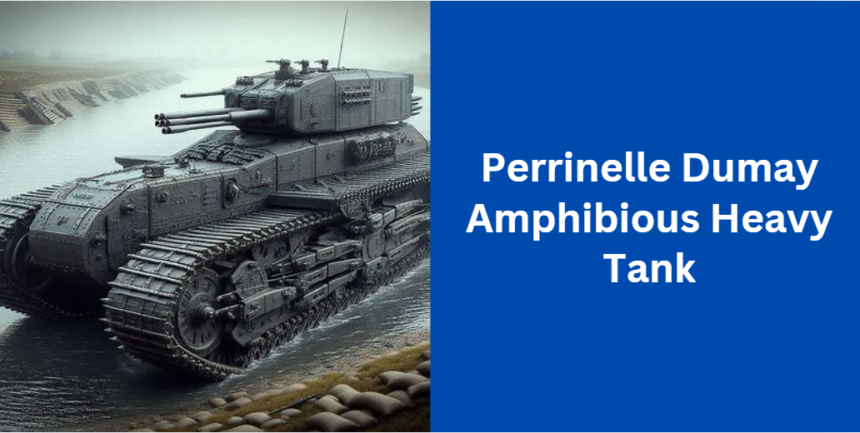The Perrinelle Dumay Amphibious Heavy Tank is one of the most intriguing yet obscure tank concepts in military history. Designed between 1918 and 1933 by French naval officer Louis Paul André de Perrinelle-Dumay, this massive war machine was intended to be superior in both firepower and mobility. Measuring nearly 20 meters in length and weighing approximately 84 tonnes, it was a revolutionary concept that could theoretically cross wide trenches and operate in water.
Despite its ambitious design, the Perrinelle Dumay Amphibious Heavy Tank was never built. Military experts dismissed it as impractical, and technological limitations of the time made its production unfeasible. However, the design provides valuable insight into early 20th-century tank development and remains a fascinating “what-if” in armored warfare history.
In this guide, we will explore its design, intended role, reasons for cancellation, and how it compares to other tanks of the era.
Origins and Development
The Man Behind the Design
The idea for the Perrinelle Dumay Amphibious Heavy Tank came from Louis Paul André de Perrinelle-Dumay, a French naval officer who envisioned a massive tank capable of crossing rivers and wide trenches.
After World War I, military strategists recognized that tanks needed better mobility to navigate the heavily fortified battlefields of the future. Perrinelle-Dumay believed that a longer, heavily armed, and amphibious tank would provide a crucial advantage in warfare.
France’s Post-WWI Military Strategy
Following the First World War, France focused heavily on tank innovation. While smaller tanks like the Renault FT had proven effective, military planners sought heavier and more advanced designs to counter evolving battlefield threats.
The Perrinelle Dumay Amphibious Heavy Tank was conceptualized as a trench-crossing and river-fording beast, allowing it to break through enemy defenses without needing bridges or additional engineering support.
Design and Features of the Perrinelle Dumay Amphibious Heavy Tank
The Perrinelle Dumay Amphibious Heavy Tank was an unprecedented design for its time. Below, we explore its key technical specifications and capabilities.
Dimensions and Weight
| Feature | Specification |
|---|---|
| Length | ~20 meters |
| Weight | ~84 tonnes |
| Width | Estimated 4-5 meters |
| Height | Estimated 3-4 meters |
| Crew Size | Estimated 6-8 men |
The sheer size of the tank was intended to allow it to cross trenches up to 5 meters wide. However, its weight posed serious mobility challenges, especially for the underdeveloped roads of the time.
Armor Protection
The armor was designed to withstand heavy artillery fire, making it one of the most well-protected tanks of its time.
- Front Armor: 60-80 mm thick
- Side Armor: 60-80 mm
- Roof Armor: 40-50 mm
- Floor Armor: 30 mm
This level of protection exceeded many tanks of the era, making it an incredibly durable war machine.
Firepower and Weapons
The Perrinelle Dumay Amphibious Heavy Tank was heavily armed to engage both enemy infantry and armored vehicles.
Primary Weapons:
- Two 65 mm cannons (mounted on the hull)
- One 47 mm gun (for engaging enemy armor)
Secondary Armament:
- Five machine guns strategically placed for 360-degree coverage
This firepower would have made it a formidable battlefield presence, capable of engaging multiple targets simultaneously.
Amphibious Capabilities
One of its most unique features was its ability to traverse water. The tank was designed with:
- Waterproof hull construction
- Buoyancy mechanisms
- Propulsion system for river crossing
This feature would have allowed it to bypass enemy defenses by swimming across rivers, rather than relying on vulnerable bridges.
Strategic Purpose and Battlefield Role
The Perrinelle Dumay Amphibious Heavy Tank was envisioned as a breakthrough vehicle capable of leading assaults against fortified enemy positions.
Its primary battlefield roles included:
- Trench Crossing: The tank’s long hull allowed it to bridge massive gaps, an advantage over conventional tanks.
- River Assaults: Unlike traditional tanks that required engineering support to cross rivers, it could swim across obstacles independently.
- Fire Support: With multiple cannons and machine guns, it would have provided continuous firepower against enemy defenses.
However, its massive size and slow speed raised concerns about its practicality.
Why the Perrinelle Dumay Amphibious Heavy Tank Was Never Built
Despite its impressive specifications, the Perrinelle Dumay Amphibious Heavy Tank never reached production. Several key factors contributed to its cancellation:
- Engineering Challenges: The weight and size made mobility a serious issue, especially on soft terrain.
- High Costs: Developing such a large and complex vehicle would have required significant financial investment.
- Changing Military Doctrine: France shifted towards smaller, more agile tanks, like the Renault FT and Char B1.
- Lack of Industrial Feasibility: Tank technology was not advanced enough to support such an ambitious design.
Comparisons to Other Tanks of the Era
| Tank Model | Weight | Primary Armament | Amphibious Capability |
|---|---|---|---|
| Perrinelle Dumay | 84 tonnes | 2 × 65 mm + 47 mm | Yes |
| Char 2C | 69 tonnes | 75 mm + machine guns | No |
| Renault FT | 6.5 tonnes | 37 mm gun | No |
Compared to other tanks, the Perrinelle Dumay Amphibious Heavy Tank was massively overbuilt and far ahead of its time.
Legacy and Lessons Learned
Although never built, the Perrinelle Dumay Amphibious Heavy Tank concept influenced later amphibious tank designs, such as:
- The Soviet T-37A (1932)
- The US M29 Weasel (WWII)
The idea of trench-crossing heavy tanks was later realized in vehicles like the WWII Churchill AVRE.
FAQs About the Perrinelle Dumay Amphibious Heavy Tank
Did the Perrinelle Dumay Amphibious Heavy Tank have any suspension system to support its massive weight?
While there is no detailed documentation on its suspension, experts speculate that it would have required a complex multi-bogie system to distribute weight and maintain mobility on uneven terrain. However, given the era’s technological limitations, designing a functional suspension for such a large tank would have been extremely difficult.
Was there any prototype or scale model ever built?
No known prototype or scale model of the Perrinelle Dumay Amphibious Heavy Tank was ever constructed. The concept remained largely theoretical, existing only in blueprints and design proposals before being abandoned.
How would the tank have navigated in water if completed?
The design suggested buoyancy aids and a propulsion system, likely consisting of rear-mounted propellers or paddle wheels. These would have allowed it to move slowly across rivers or lakes. However, whether such a system could support an 84-ton tank remains highly questionable.
What kind of fuel would the Perrinelle Dumay Amphibious Heavy Tank have used?
Given the time period, the tank would have likely been powered by a large diesel or gasoline engine. However, a major concern would have been fuel efficiency and refueling logistics, as a tank of this size would have consumed enormous amounts of fuel, limiting its operational range.
Could modern technology make the Perrinelle Dumay Amphibious Heavy Tank a reality today?
With advancements in lightweight composite armor, high-efficiency engines, and amphibious propulsion, a modern version of this tank could theoretically be built. However, military doctrines today favor lighter, more mobile vehicles over large, heavily armored designs, making such a project unlikely.
Conclusion
The Perrinelle Dumay Amphibious Heavy Tank remains a fascinating example of bold but impractical military engineering. While its design was revolutionary, it was ultimately too large, expensive, and ahead of its time.
However, its ambitious vision paved the way for future amphibious and heavy tank developments, making it an important footnote in the history of armored warfare.
Would this tank have worked if built with modern technology? That remains an open question—but its legacy continues to inspire military historians and enthusiasts today.
Read more posts like
76ers vs Knicks Match Player Stats: The Complete Guide
The Ultimate Guide to Food Jalbiteblog
In-Depth Analysis Of 2006 Volleyball Massacre.png
The Ultimate Guide to Artist Directory ArcyArt: Boost Your Artistic Presence
Válcovačka závitů drátu na kola – The Ultimate Guide for Cyclists and Professionals





